热门标签
热门文章
- 1钉钉手机端调试前端H5项目流程_钉钉浏览器调试
- 2FPGA学习回顾_output reg
- 38个vue前端UI框架框架值得你掌握,前端开发面试基础_vue ui框架
- 407 JS CORE 数组_core js 数组方法
- 5解决VMware虚拟机更新17.5.0版本后,启动虚拟机导致电脑重启的问题。(建议收藏)_vmware 17.5
- 6利用 matplotlib 库在一张独立的画布上绘制以下五个图表_matplotlib题目
- 7Java 经典《Java 核心技术》上出现虚竹哥的名字,居然是因为
- 82023年7月25日 Go生态洞察:Go开发者调查分享
- 9failed to get sandbox image \\\“registry.k8s.io/pause:3.6\\\“: failed to pull image \\\“registry.k8
- 10建议收藏:OpenKruise入门与实践
当前位置: article > 正文
双目立体视觉摄像头的标定、矫正、世界坐标计算(opencv)
作者:盐析白兔 | 2024-05-21 17:34:28
赞
踩
立体视觉摄像头
摄像头标定准备工作
使用双目摄像头拍摄贴有棋盘格的平面,拍摄多组图片,要保证左右相机均能够拍摄到完整的方格。并测量棋盘格方格的实际尺寸。
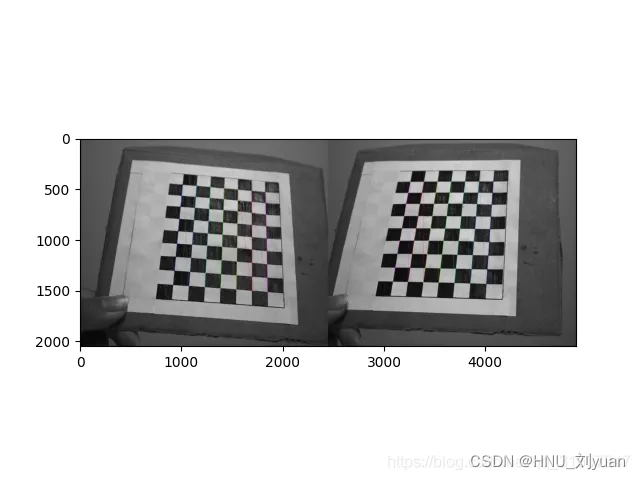
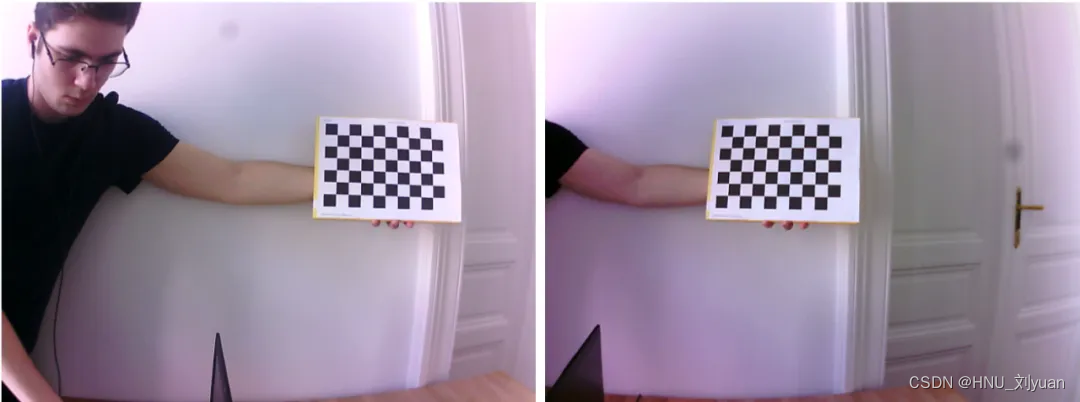
摄像头标定
对步骤1拍摄的到的左右相机的照片进行处理,分别计算左右相机的参数。
cheese_size = (11, 8) # 棋盘格图片在长宽方向上包含格子的个数 corner_num = cheese_size[0] * cheese_size[1] unit = 20 # 实际的格子间距这里是 20mm objp = np.zeros((corner_num, 3), np.float32) objp[:, :2] = np.mgrid[0:cheese_size[0], 0:cheese_size[1]].T.reshape(-1, 2) objp *= unit print("objp:", objp.shape) stereo_right_images = [] stereo_left_images = [] objpoints = [] save = True for fn in fns: print(fn) left_img = cv2.imread(fn) stereo_left_images.append(left_img) # opencv读取视频 right_img = cv2.imread(fn.replace('left', 'right')) stereo_right_images.append(right_img) objpoints.append(objp) print(len(stereo_left_images), len(stereo_right_images)) # 单目标定 x, stereo_right_corners = calibrate( stereo_right_images, objpoints, cheese_size=cheese_size, show_img=True, fnames=fns) stereo_right_ret, stereo_right_mtx, stereo_right_dist, stereo_right_rvecs, stereo_right_tvecs = x # stereo_nir_dist = np.zeros_like(stereo_nir_dist) print('right cali done...') x, stereo_left_corners = calibrate( stereo_left_images, objpoints, cheese_size=cheese_size, show_img=True, fnames=fns) stereo_left_ret, stereo_left_mtx, stereo_left_dist, stereo_left_rvecs, stereo_left_tvecs = x print('left cali done...') if _DIST_: print('--------------------------------------------------------------------') stereo_right_dist = np.zeros_like(stereo_right_dist) stereo_left_dist = np.zeros_like(stereo_left_dist) # 双目标定 retval, stereo_left_mtx, stereo_left_dist, stereo_right_mtx, stereo_right_dist, R_left2right, T_left2right, E_left2right, F_left2right= \ cv2.stereoCalibrate(np.array(objpoints), np.squeeze(np.array(stereo_left_corners)), np.squeeze(np.array(stereo_right_corners) ), stereo_left_mtx, stereo_left_dist, stereo_right_mtx, stereo_right_dist, (stereo_left_images[0].shape[0], stereo_left_images[0].shape[1]) # flags=cv2.CALIB_RATIONAL_MODEL ) # python3 transfer stereo_left -> stereo_righ tflags=cv2.CALIB_RATIONAL_MODEL h, w, c = stereo_right_images[0].shape print('stereo cali done...') if _DIST_: stereo_right_dist = np.zeros_like(stereo_right_dist) stereo_left_dist = np.zeros_like(stereo_left_dist)
- 1
- 2
- 3
- 4
- 5
- 6
- 7
- 8
- 9
- 10
- 11
- 12
- 13
- 14
- 15
- 16
- 17
- 18
- 19
- 20
- 21
- 22
- 23
- 24
- 25
- 26
- 27
- 28
- 29
- 30
- 31
- 32
- 33
- 34
- 35
- 36
- 37
- 38
- 39
- 40
- 41
- 42
- 43
- 44
- 45
- 46
- 47
- 48
- 49
- 50
- 51
- 52
- 53
- 54
- 55
- 56
- 57
其中的calibrate函数为:
def calibrate(images, objpoints, cheese_size, show_img=False, fnames=[]): # termination criteria criteria = (cv2.TERM_CRITERIA_EPS + cv2.TERM_CRITERIA_MAX_ITER, 50, 0.001) # 终止迭代标准,最大迭代次数或者到达精度 imgpoints = [] num = 0 for img in images: gray = cv2.cvtColor(img, cv2.COLOR_BGR2GRAY) ret, corners = cv2.findChessboardCorners(gray, cheese_size, None)# 检测输入图片是否含有棋盘图片 # If found, add object points, image points (after refining them) if ret == True: cv2.cornerSubPix(gray, corners, (5, 5), (-1, -1), criteria) # 亚像素角点检测 # print(corners) imgpoints.append(corners) if show_img: # Draw and display the corners img = np.copy(img) cv2.drawChessboardCorners(img, cheese_size, corners, ret) # 棋盘格角点绘制 cv2.imshow('img' , img) cv2.imwrite("right.jpg", img) cv2.waitKey(3) num = num + 1 if show_img: cv2.destroyAllWindows() # input('回车下一步') return cv2.calibrateCamera(objpoints, imgpoints, gray.shape[::-1], None, None), imgpoints #求出内参和每一个视角的外参数
- 1
- 2
- 3
- 4
- 5
- 6
- 7
- 8
- 9
- 10
- 11
- 12
- 13
- 14
- 15
- 16
- 17
- 18
- 19
- 20
- 21
- 22
- 23
- 24
- 25
- 26
- 27
- 28
- 29
此过程能够自动检测图片中的棋盘格图片进行参数计算,得到两个摄像头的内外参数矩阵,以及两个摄像头之间的位置关系。
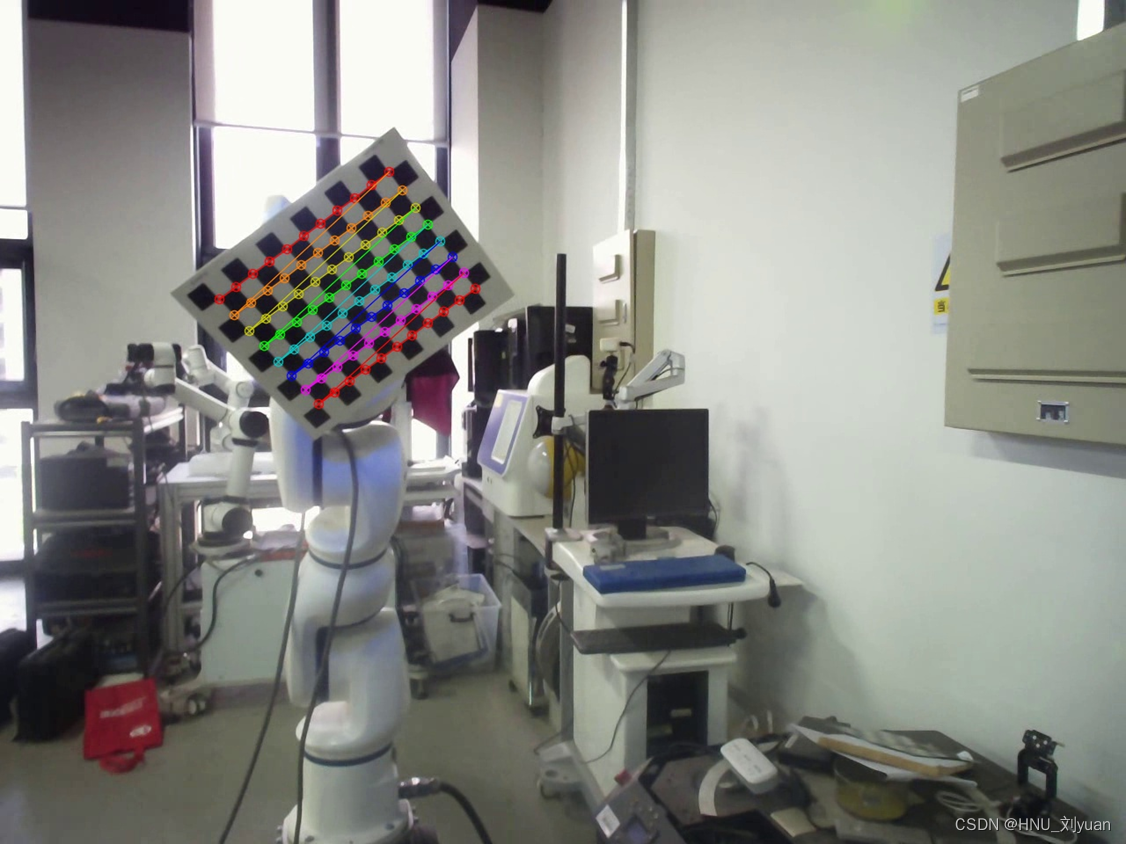
摄像头矫正
此时能够得到每一个摄像头的参数,但是实际中并不是理想的双目视觉模型,Bouguet立体校正算法,其核心原理是通过像素平面透视变换,使左右图像重投影误差最小,使双目系统最接近理想状态。也就是立体矫正。
# 双目矫正
R1, R2, P1, P2, Q, validPixROI1, validPixROI2 = cv2.stereoRectify(
stereo_left_mtx, stereo_left_dist, stereo_right_mtx, stereo_right_dist, (w, h), R_left2right, T_left2right, alpha=0)
R1[0, :] *= -1
R2[0, :] *= -1
print('stereo rectify done...')
# 得到映射变换
stereo_left_mapx, stereo_left_mapy = cv2.initUndistortRectifyMap(
stereo_left_mtx, stereo_left_dist, R1, P1, (w, h), 5)
stereo_right_mapx, stereo_right_mapy = cv2.initUndistortRectifyMap(
stereo_right_mtx, stereo_right_dist, R2, P2, (w, h), 5)
print('initUndistortRectifyMap done...')
- 1
- 2
- 3
- 4
- 5
- 6
- 7
- 8
- 9
- 10
- 11
- 12
- 13
并可以将其中的关键参数保存下来。
if save:
np.save('P1', P1)
np.save('P2', P2)
np.save('stereo_right_mtx', stereo_right_mtx)
np.save('stereo_right_dist', stereo_right_dist)
np.save('stereo_left_mtx', stereo_left_mtx)
np.save('stereo_left_dist', stereo_left_dist)
np.save('R_left2right', R_left2right)
np.save('T_left2right', T_left2right)
- 1
- 2
- 3
- 4
- 5
- 6
- 7
- 8
- 9
通过可视化验证是否对其:
# 可视化验证,看网格是否对齐 def drawLine(img, num=16): h, w, *_ = img.shape for i in range(0, h, h // num): cv2.line(img, (0, i), (w, i), (0, 255, 0), 1, 8) return img for fn in fns: left_img = cv2.imread(fn) right_img = cv2.imread(fn.replace('left', 'right')) frame0 = cv2.remap(right_img, stereo_right_mapx, stereo_right_mapy, cv2.INTER_LINEAR) frame1 = cv2.remap(left_img, stereo_left_mapx, stereo_left_mapy, cv2.INTER_LINEAR) img = np.concatenate((frame0, frame1), axis=1).copy() img = drawLine(img, 32) cv2.imshow('img', img) ret = cv2.waitKey(3)
- 1
- 2
- 3
- 4
- 5
- 6
- 7
- 8
- 9
- 10
- 11
- 12
- 13
- 14
- 15
- 16
- 17
- 18
- 19
- 20
- 21
矫正之后的图片棋盘格之间应该是对齐的,在同一高度。
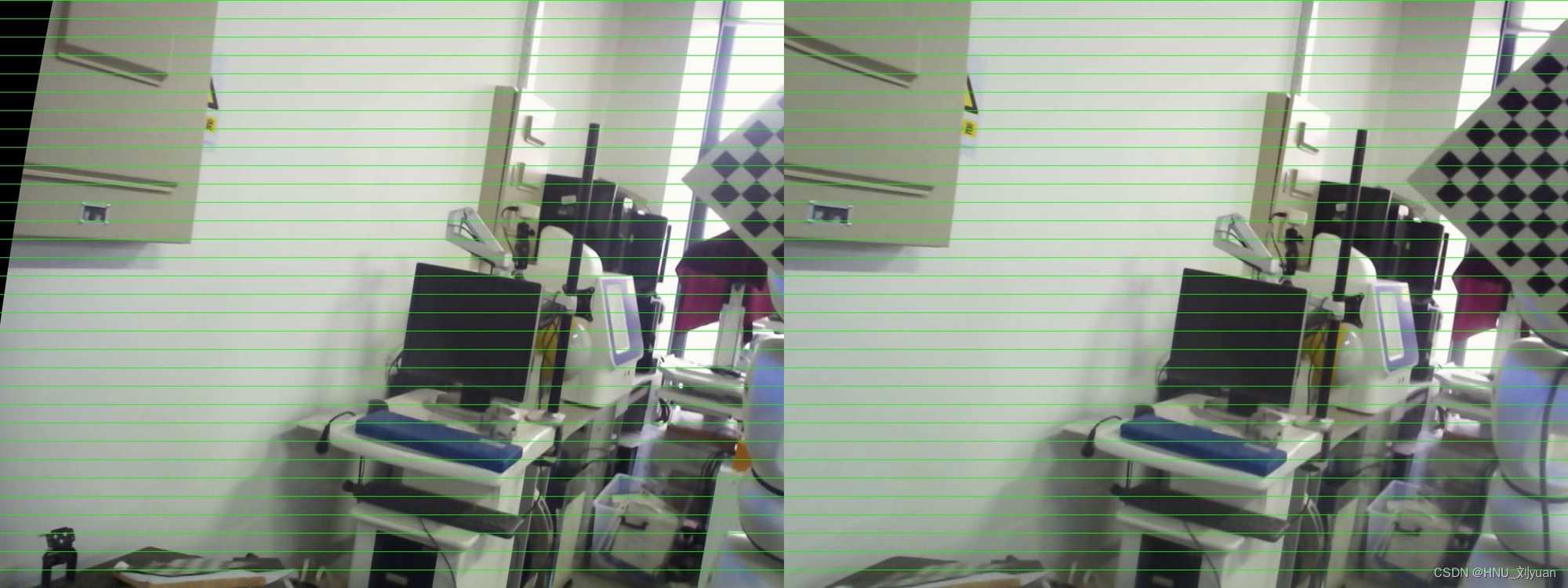
此时就完成了相机的标定和矫正工作。
世界坐标计算
得到相机的参数之后,假如知道同一个点在左右视频中的位置,就能够计算其三维坐标位置。
利用跟踪或者其他算法得到某个固定点在左右摄像头的像素坐标,保存为txt文件,使用left_path 和right_path 代表其路径。
import numpy as np import matplotlib.pylab as plt import math # [K1,K2,P1,P2,k3] def read_point(left_path,right_path): point_r=[] point_l=[] with open(left_path,"r") as f: line = f.readline().strip('\n') while line: temp=line.split(' ') point=[int(temp[0]), int(temp[1])] point_l.append(point) line=f.readline().strip('\n') with open(right_path, "r") as f: line = f.readline().strip('\n') while line: temp = line.split(' ') point = [int(temp[0]), int(temp[1])] #1280 point_r.append(point) line = f.readline().strip('\n') point_r = np.array(point_r) point_l = np.array(point_l) return point_l,point_r def computexyz(point_l, point_r, M_l,M_r): # compute XYZ ul = point_l[0] vl = point_l[1] ur = point_r[0] vr = point_r[1] # A = np.zeros((4,3)) A = np.array([[ul * M_l[2][0] - M_l[0][0], ul * M_l[2][1] - M_l[0][1], ul * M_l[2][2] - M_l[0][2]], [vl * M_l[2][0] - M_l[1][0], vl * M_l[2][1] - M_l[1][1], vl * M_l[2][2] - M_l[1][2]], [ur * M_r[2][0] - M_r[0][0], ur * M_r[2][1] - M_r[0][1], ur * M_r[2][2] - M_r[0][2]], [vr * M_r[2][0] - M_r[1][0], vr * M_r[2][1] - M_r[1][1], vr * M_r[2][2] - M_r[1][2]]]) b = np.array([M_l[0][3] - ul * M_l[2][3], M_l[1][3] - vl * M_l[2][3], M_r[0][3] - ur * M_r[2][3], M_r[1][3] - vr * M_r[2][3]]) temp1 = np.linalg.inv(np.matmul(A.T, A)) temp2 = np.matmul(A.T, b) point_xyz = np.matmul(temp1, temp2) return point_xyz left_path = "data/point_left_c.txt" right_path = "data/point_right_c.txt" point_l,point_r = read_point(left_path,right_path) distRight=np.load("stereo_right_dist.npy").squeeze() distLeft=np.load("stereo_left_dist.npy").squeeze() print(distLeft) print(distRight) m,n=point_r.shape K_r = np.load("stereo_right_mtx.npy") R_r = np.load("R_left2right.npy") t_r = np.load("T_left2right.npy").squeeze() R_l = np.eye(3) t_l = np.array([0,0,0]) P_r = np.zeros((3,4)) P_r[:, 0:3] = R_r P_r[:, 3] = t_r M_r=np.matmul(K_r,P_r) K_l = np.load("stereo_left_mtx.npy") P_l = np.zeros((3,4)) P_l[:, 0:3] = R_l P_l[:, 3] = t_l M_l=np.matmul(K_l,P_l) Point = [] for i in range(len(point_l)): Pointxyz = computexyz(point_l[i],point_r[i],M_l,M_r) Point.append(Pointxyz) Point = np.array(Point) fig = plt.figure() ax = fig.add_subplot(111, projection='3d') ax.scatter(Point[:,0], Point[:,1], Point[:,2]) ax.set_xlabel('x') ax.set_ylabel('y') ax.set_zlabel('z') plt.show()
- 1
- 2
- 3
- 4
- 5
- 6
- 7
- 8
- 9
- 10
- 11
- 12
- 13
- 14
- 15
- 16
- 17
- 18
- 19
- 20
- 21
- 22
- 23
- 24
- 25
- 26
- 27
- 28
- 29
- 30
- 31
- 32
- 33
- 34
- 35
- 36
- 37
- 38
- 39
- 40
- 41
- 42
- 43
- 44
- 45
- 46
- 47
- 48
- 49
- 50
- 51
- 52
- 53
- 54
- 55
- 56
- 57
- 58
- 59
- 60
- 61
- 62
- 63
- 64
- 65
- 66
- 67
- 68
- 69
- 70
- 71
- 72
- 73
- 74
- 75
- 76
- 77
- 78
- 79
- 80
- 81
- 82
- 83
- 84
- 85
- 86
- 87
- 88
- 89
- 90
- 91
- 92
- 93
- 94
- 95
即可得到如下所示的三维轨迹图。
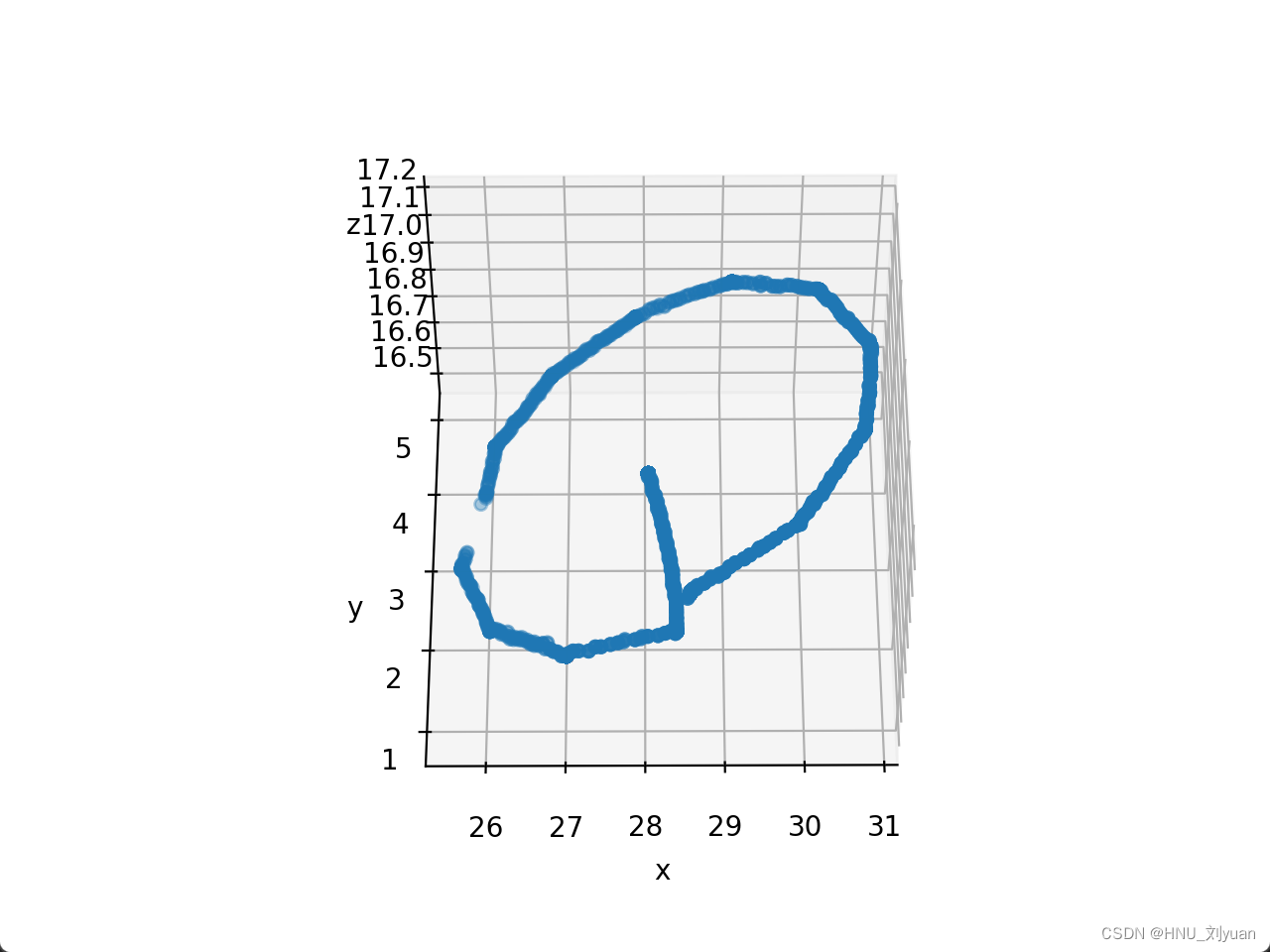
具体的原理部分可以参考其余博客,写的都挺好。
声明:本文内容由网友自发贡献,不代表【wpsshop博客】立场,版权归原作者所有,本站不承担相应法律责任。如您发现有侵权的内容,请联系我们。转载请注明出处:https://www.wpsshop.cn/w/盐析白兔/article/detail/603838
推荐阅读
相关标签




